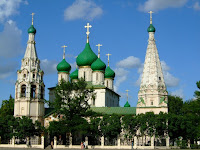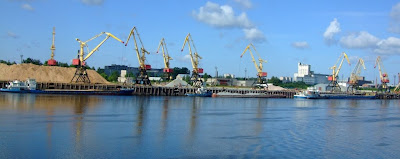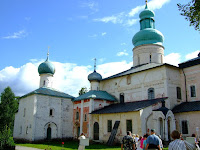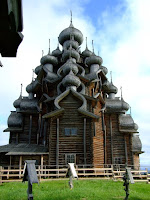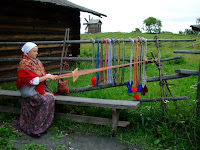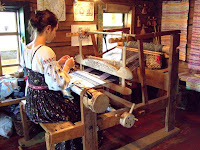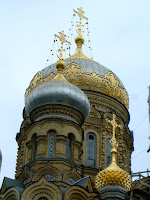
The included tour for the morning was to the Hermitage Museum in central St Petersburg. The current museum curator claims it would take 18 years to see all the exhibits, and although we covered some 6 km of corridors in our visit we only had two hours to snatch a few highlights. Since some parts of the Hermitage were originally a palace, the rooms themselves are treasures regardless of whether they have contents or not.

Other "plainer" rooms hold art works. There is a large collection of Rembrandts and an impressive French impressionists and post-impressionists section.

Surprisingly, there is only one Carravagio in Russia and it is not a particularly good example of Carravagio's amazing use of light and shade. Two paintings by Da Vinci and another Madonna & Child by Raffaello were originally on wood, but this was not an appropriate backing for the Russian climate so they have had the wood removed from the rear of the paint and then replaced with canvas, all without destroying the masterpiece; absolutely amazing.

Quite incredibly, a 100 rouble permit allows visitors to take pictures throughout, the only restriction being no flash in the art gallery; a restriction disobeyed by many, and certainly not enforced by the babushkas sitting in each room, so the Matisse that was the feature of the Russian exhibition in the Royal Academy in London recently was uncrowded and able to photographed; quite the opposite from when we last saw it. The Hermitage is the largest museum in the world and certainly has an impressive art collection.

A chandelier in one of the first rooms we visited weight 2.5 tonnes and when it was candlelit, the best candles money could buy would only last 40 minutes before the guests had to be moved out of the room, the chandelier lowered and the candles replaced.
There was a choice of three afternoon excursions and we chose Pushkin (or Catherine's) Palace. Almost completely destroyed by a fire lit by the retreating Nazis in WWII it is slowly being restored to its former glory with about half of the

55 impressive reception rooms restored so far. Catherine intended to out-do every other royal in Europe and her golden corridor of 15 or so rooms is certainly mind bogglingly impressive opening, as they do in a continuous sequence of door after door after door. The main hall was one of the first restored and is now due for re-gilding with another 4 kg of gold leaf.


The jewel in the crown, and the only place where photos are not permitted, is the Amber Room. The original panels were spirited away by the Nazis and although seen in German hands in another Russian town shortly thereafter have been "lost", whether on the bottom of the Baltic or into a private collection somewhere is unknown.

 Yesterday's tour was very late in the afternoon, this morning's was bright and early as we disembarked at Uglich. It was really 'same old, same old' and the general impression was that the group was suffering from church-lag. There is also an over exposure of a cappella church/folk choirs: 3 voices at Kizhi; 4 at Krillov; 5 at Yarosavl; and two choirs of 5 this morning, the only new thing being 3 female singers in one choir.
Yesterday's tour was very late in the afternoon, this morning's was bright and early as we disembarked at Uglich. It was really 'same old, same old' and the general impression was that the group was suffering from church-lag. There is also an over exposure of a cappella church/folk choirs: 3 voices at Kizhi; 4 at Krillov; 5 at Yarosavl; and two choirs of 5 this morning, the only new thing being 3 female singers in one choir.

 The official verdict was later decreed to be be that he cut his own throat while suffering an epileptic fit. The bell having, thus, alerted the townsfolk erroneously was taken down from the bell-tower, whipped and sent into exile in Siberia on the backs of some townsfolk. The bell has since been returned to Uglich and is displayed in the church built on the site of Demetri's unfortunate demise.
The official verdict was later decreed to be be that he cut his own throat while suffering an epileptic fit. The bell having, thus, alerted the townsfolk erroneously was taken down from the bell-tower, whipped and sent into exile in Siberia on the backs of some townsfolk. The bell has since been returned to Uglich and is displayed in the church built on the site of Demetri's unfortunate demise.


